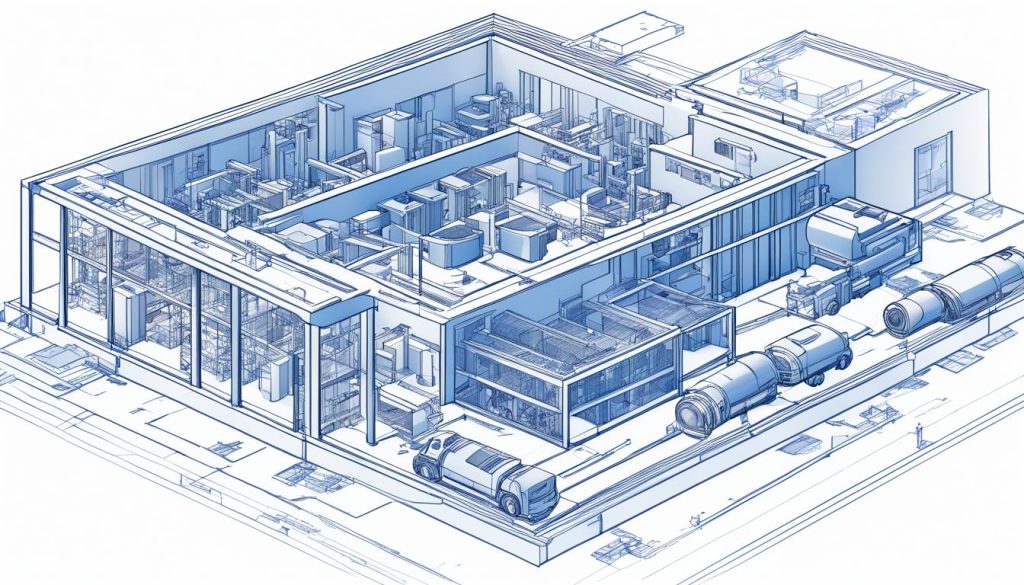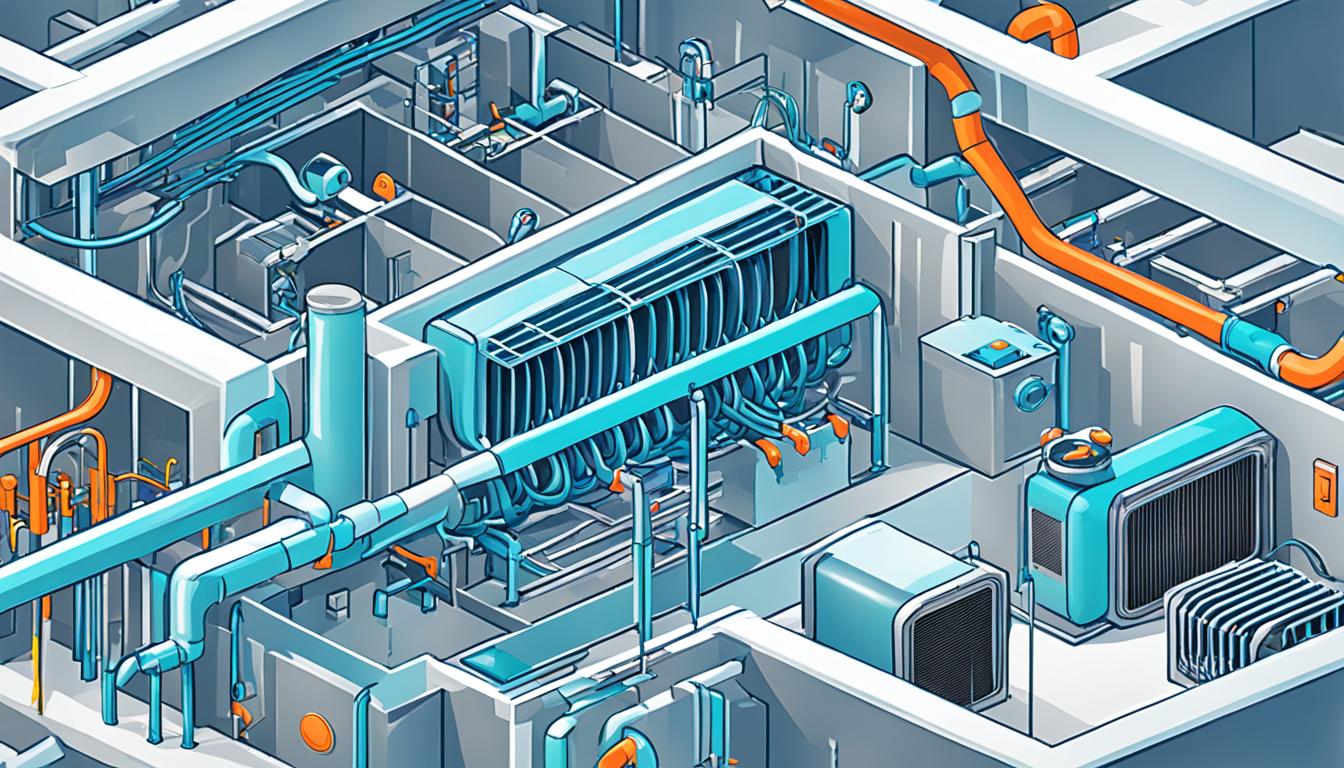AutoCAD HVAC software helps you get accurate project cost estimates. It has tools for design, drafting, and estimation. You can trace PDFs, make routed systems, and set custom prices for better cost estimation.
This software uses industry standards and has a big parts library and labor cost planner. These features help you make clear, detailed estimates for your customers. This makes managing your project costs easier.
Learning AutoCAD HVAC improves your skill in making accurate cost estimates. This helps with your project planning and talking to clients. It’s a key tool for HVAC pros who want to work better and give precise quotes.
Introduction to AutoCAD HVAC Software for Cost Estimation
AutoCAD HVAC software changes the game in MEP design and cost estimation. It blends advanced drafting with strong estimation tools. This makes your project workflow smoother from start to finish.
AutoCAD has HVAC-specific features for designing projects. You can use built-in standards and parts libraries. This makes your designs accurate and consistent, saving time and cutting down on mistakes.
The cost estimation tools are top-notch too. You can set up pricing systems for detailed cost breakdowns. This gives you better control over your project budget. Plus, you can schedule labor costs precisely, helping you manage your team well.
AutoCAD HVAC software combines drawing and estimation tools in one. This means you don’t need extra programs. It makes your work easier and boosts project efficiency.
| AutoCAD HVAC Feature | Benefit |
|---|---|
| Built-in standards | Ensures compliance and consistency |
| Full parts libraries | Speeds up design process |
| Customizable pricing systems | Enables accurate cost breakdowns |
| Labor cost scheduling | Facilitates precise resource management |
AutoCAD’s software is great for both experts and newcomers in HVAC design. It has tools for efficient, accurate, and cost-effective planning. Its easy-to-use interface and strong features make it a key tool for HVAC projects.
Understanding the Basics of HVAC System Design in AutoCAD
AutoCAD HVAC software changes the game in HVAC system design. It makes complex processes easier. This tool brings together important design aspects for accuracy and efficiency in your projects.
Load Calculations and System Sizing
Load calculations are key in HVAC system design. With AutoCAD HVAC software, you can enter building details, how many people will use the space, and the local weather. It then does precise calculations to figure out heating and cooling needs.
After that, the software suggests the best system sizes. This makes sure your HVAC system fits the needs of each space perfectly. It won’t be too big or too small.
Equipment Selection and Placement
After figuring out the loads, AutoCAD HVAC helps pick the right equipment. It has a big database of HVAC parts. You can choose the best one for your project, thinking about energy use, cost, and space.
Where you put the equipment is also important for efficiency. AutoCAD HVAC has tools to help you see and place equipment well. This ensures good airflow and easy maintenance access.
Ductwork Layout and Sizing
Designing ductwork is key for a good HVAC system. AutoCAD HVAC makes this easier with tools for ductwork layout and sizing. It looks at air speed, pressure, and noise to make the best duct designs.
| Design Aspect | AutoCAD HVAC Feature | Benefit |
|---|---|---|
| Load Calculations | Automated calculation tools | Precise system sizing |
| Equipment Selection | Component database | Optimal equipment choice |
| Ductwork Design | Automated layout tools | Efficient air distribution |
AutoCAD HVAC software brings together these important parts. It lets you make detailed, efficient HVAC system designs. And it makes the whole project easier to manage.
Leveraging AutoCAD’s Drawing Tools for HVAC Projects
AutoCAD has powerful tools for HVAC drafting and MEP design. These tools make creating HVAC systems easier and more accurate. This means your projects will be more efficient.
Working on HVAC projects in AutoCAD is easy thanks to its intuitive features. The Libraries Palette gives you access to many pre-built components. This saves time and keeps your designs consistent.
AutoCAD is great for HVAC drafting because you can trace PDFs using routed systems. This turns old plans into digital formats easily. You can also quickly change parts using AutoCAD’s quick selection tools.
AutoCAD gives you full control over your drawings. You can change standards and parameters as needed. This is key in HVAC design, where making changes is common to improve system performance. The automatic annotation feature also boosts productivity by adding labels and notes to your drawings.
- Utilize the Libraries Palette for quick access to HVAC components
- Trace PDFs to convert existing plans into digital formats
- Use quick selection tools for efficient part modification
- Take advantage of automatic annotation for detailed labeling
Using these AutoCAD tools, you can make HVAC designs that are both accurate and cost-effective. The software’s MEP design capabilities lead to more precise cost estimates. This helps you deliver great results for your clients.
Integrating HVAC Standards and Libraries in AutoCAD
AutoCAD HVAC software gives engineers powerful tools for combining industry standards and large parts libraries. This makes designing easier and ensures designs follow the rules.
Incorporating Duct Construction Standards
AutoCAD HVAC has built-in duct construction standards. This lets you design systems that follow industry rules. You can focus on duct size, material, and insulation needs.
- SMACNA guidelines for duct construction
- ASHRAE standards for energy efficiency
- Local building codes for HVAC installations
Utilizing Built-in Parts Libraries
The software has big parts libraries, which saves time and makes your designs more accurate. These libraries have many HVAC parts, like air handlers and diffusers.
| Component Category | Examples |
|---|---|
| Air Distribution | Diffusers, Grilles, Dampers |
| Heating Equipment | Boilers, Radiators, Heat Pumps |
| Cooling Equipment | Chillers, Cooling Towers, Condensers |
| Ventilation | Fans, Air Handlers, Ductwork |
Customizing Components and Sub-Assemblies
AutoCAD HVAC lets you customize parts and sub-assemblies. This means you can make unique parts for your project. It makes your designs more accurate and helps with cost planning.
Using these tools, you can make detailed HVAC designs. They follow industry standards and are efficient and accurate from start to finish.
Use AutoCAD for Project Cost Estimation
AutoCAD is a key tool for estimating costs in construction. It combines database tools with drawing features. This lets you make detailed estimates from your designs.
With AutoCAD, you can use customizable parts and sub-assemblies for estimation. This means you can price your project exactly how you need to. The Fitting Input Batch function makes estimating costs for fittings and components easier.
AutoCAD is great at making detailed summaries for estimation. These summaries let you view costs in different ways. You can look at costs by:
- Number of AHUs (Air Handling Units)
- Square footage
- Weight
- CFM (Cubic Feet per Minute)
- Building floors
This flexibility in cost breakdown gives you deep insights into your project’s finances. Using AutoCAD for estimation helps you make better budgets. It also helps you find ways to save money and manage construction costs better.
Tracing PDFs and Creating Routed Systems in AutoCAD
AutoCAD HVAC software makes projects more efficient with PDF tracing and routed systems. These tools help with estimation and improve HVAC design accuracy. Let’s see how you can use these tools for your projects.

Techniques for Efficient PDF Tracing
PDF tracing in AutoCAD lets you turn existing plans into editable drawings fast. First, import your PDF into AutoCAD. Then, use the PDF underlay feature to trace over the elements. This saves time and cuts down on mistakes in making designs from scratch.
For HVAC projects, focus on tracing ductwork, equipment locations, and structural elements. These affect the system’s layout.
Developing Routed Systems for Accurate Estimations
Routed systems in AutoCAD HVAC software give you precise material takeoffs and cost calculations. Start by setting up your system parameters like duct sizes, insulation types, and fittings. Use the Libraries Palette to find and customize pre-built components.
As you draw your HVAC layout, the software automatically calculates lengths and quantities. This gives you real-time estimation data.
By using PDF tracing and routed systems together, you get a strong workflow for AutoCAD estimation. This method makes your HVAC design accurate and cost-effective. The final drawings can turn into detailed BIM models, improving your project’s efficiency and coordination.
Detailed Material and Labor Cost Breakdown in AutoCAD
AutoCAD is a powerful tool for HVAC estimation. It lets you make detailed cost breakdowns. You can analyze both material and labor costs with precision. This software helps you get accurate cost estimates for HVAC projects.
AutoCAD’s material costs feature lets you price out every HVAC component. You can enter specific costs for ductwork and equipment. This detailed pricing ensures your estimates are thorough and precise.
Labor costs are key in HVAC estimation too. AutoCAD has tools for scheduling labor. These tools calculate costs based on project time and worker numbers. For projects with the Sheet Metal Worker Union, the software automatically uses Union Foreman, Journeyman, and Apprentice ratios.
| Cost Type | AutoCAD Feature | Benefit |
|---|---|---|
| Material Costs | Component Pricing | Accurate itemization |
| Labor Costs | Scheduling Tools | Precise labor estimation |
| Union Labor | Automatic Ratio Application | Compliance with union requirements |
By using these features together, you can make a full cost breakdown for HVAC projects. This detailed method of estimation gives you accurate quotes for clients. It also helps you manage project budgets well.
Utilizing AutoCAD’s BIM Integration for Enhanced Estimation
AutoCAD’s BIM integration tools make project cost estimation better. They combine AutoCAD’s precision with BIM’s data management. This leads to more accurate and detailed cost analyses.
Exporting IFC Files to Revit
AutoCAD HVAC software lets you export Industry Foundation Classes (IFC) files. These files work with Revit. This makes sharing data between BIM platforms easy, improving teamwork and info sharing.
To export IFC files from AutoCAD:
- Open your HVAC project in AutoCAD
- Go to the “Export” menu
- Select “IFC” as the file format
- Choose the desired IFC version
- Specify the export settings
- Save the IFC file
Leveraging BIM Data for Cost Analysis
After your HVAC design is in a BIM setting, you can use its data for detailed cost analysis. BIM models have info on materials, quantities, and specs. This info helps in making accurate cost estimates.
- Automatic quantity takeoffs
- Real-time cost updates as design changes occur
- Improved accuracy in material and labor estimates
- Enhanced visualization of cost-intensive areas
| BIM Integration Feature | Impact on Cost Estimation |
|---|---|
| 3D Visualization | Identifies potential conflicts and costly rework |
| Parametric Modeling | Allows quick cost comparisons of design alternatives |
| Data-rich Components | Provides accurate material and equipment costs |
| Clash Detection | Reduces unexpected expenses during construction |
Using AutoCAD’s BIM integration, you can make more detailed and accurate cost estimates for HVAC projects. This method improves your estimates’ precision. It also helps in better communication with clients and team members during the project.
Automating Takeoffs and Quantity Calculations in AutoCAD
AutoCAD HVAC software changes the game with automated takeoffs and quantity calculations. It makes estimating project costs faster and more accurate. This feature saves time and cuts down on mistakes in HVAC estimation.
Setting Up Automated Quantity Takeoffs
To start automated takeoffs in AutoCAD, first define your project details. Make custom blocks for HVAC parts and give each one attributes. This lets the software keep track of quantities and specs as you design.

Then, use the Data Extraction Wizard in AutoCAD to pull info from your drawings. Create filters to focus on the HVAC parts you need, making sure your quantity calculations are spot-on for your estimates.
Generating Accurate Bill of Materials
After setting up your automated takeoffs, making a bill of materials is easy. AutoCAD gathers data from your drawings to create a detailed list of HVAC parts, how many you need, and their specs.
| HVAC Component | Quantity | Specifications |
|---|---|---|
| Air Handling Units | 4 | 20,000 CFM capacity |
| Ductwork | 500 linear feet | Galvanized steel, 24-gauge |
| Diffusers | 50 | 12″ x 12″ square, adjustable |
This automated method makes your HVAC estimates precise. It lays a strong base for cost analysis and client proposals. By using AutoCAD’s automated tools, you’ll make your workflow smoother and your HVAC projects more accurate.
Customizing Pricing Systems and Labor Rates in AutoCAD
AutoCAD HVAC software lets you make pricing systems and labor rates just right for HVAC estimation. This means you can set costs that fit your company’s needs and the project’s details.
You can make your own pricing tables in AutoCAD. These tables should show the current market rates and your business’s specifics. They can include things like material costs, labor rates, and extra expenses.
Creating Custom Cost Schedules
To set up your custom pricing system in AutoCAD:
- Open the Cost Database Manager
- Create new cost categories
- Input your specific pricing data
- Link cost items to HVAC components
Adjusting Labor Rates
Labor costs are key in HVAC estimation. With AutoCAD, you can change labor rates based on:
- Skill levels
- Project complexity
- Regional differences
- Overtime considerations
Component-Level Cost Customization
AutoCAD also lets you customize costs for HVAC components. You can set prices for things like ductwork, vents, and cooling units. This detailed pricing ensures your estimates are spot-on for each project part.
| Component | Base Cost | Labor Hours | Total Cost |
|---|---|---|---|
| Air Handler | $2,500 | 8 | $3,300 |
| Ductwork (per linear foot) | $15 | 0.5 | $27.50 |
| Thermostat | $150 | 1 | $225 |
Using these customization tools, you can make estimates for HVAC projects that are both precise and competitive. This ensures your pricing meets market needs and your business goals.
Generating Comprehensive Project Reports and Estimates
AutoCAD HVAC software makes it easy to create detailed project reports and estimates. It has advanced features that help you make accurate and professional documents. These documents impress clients and make your work flow smoother.
Creating Estimate Summaries
AutoCAD HVAC tools let you make quick, concise estimate summaries. These summaries show the project costs for materials, labor, and equipment clearly. You can customize them to focus on important details and make them easy for clients and stakeholders to understand.
Producing Detailed Cost Breakdowns
AutoCAD HVAC software helps you make detailed cost breakdowns. It automatically figures out quantities and prices, ensuring your estimates are accurate. You can easily update your breakdowns if there are changes in materials or labor rates.
Developing Client-Ready Proposal Documents
AutoCAD HVAC lets you create professional proposal documents. You can add project drawings, specs, and cost estimates into one document. The software’s tools help you make your documents look good and clearly explain your project plan to clients.
Using AutoCAD HVAC’s reporting tools makes estimating and reporting easier. You can deliver top-quality reports, summaries, breakdowns, and proposals. This saves time and boosts your credibility with clients, helping you win more projects.
Conclusion
AutoCAD HVAC software is a big step forward in managing project costs. It blends design skills with exact cost management tools. This makes it perfect for making accurate HVAC system designs and detailed cost plans.
The software makes your work easier with automated takeoffs and BIM integration. It saves time and cuts down on mistakes. Plus, its easy-to-use interface lets you adjust pricing and labor rates to fit your needs. With AutoCAD HVAC, making project reports and proposals for clients is a breeze.
Using AutoCAD HVAC for your projects means more than just designing systems. It’s about optimizing your cost estimation process. This software helps you make smart choices, plan better, and manage construction costs well. It’s key to staying ahead in the fast-moving HVAC industry.





0 Comments